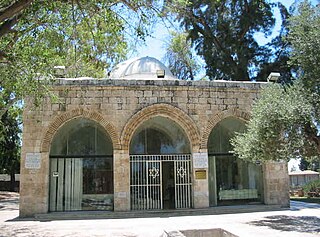
Judah ha-Nasi or Judah I, was a second-century rabbi and chief redactor and editor of the Mishnah. He lived from approximately 135 to 217 CE. He was a key leader of the Jewish community during the Roman occupation of Judea.
Johanan bar Nappaha was a leading rabbi in the early era of the Talmud. He belonged to the second generation of amoraim.
Judah III, Yudan Nesiah, was a prominent Jewish sage, who held the office of Nasi of the ancient Jewish Sanhedrin between about 290 and 320 CE.
Shimon ben Lakish, better known by his nickname Reish Lakish, was an amora who lived in the Roman province of Judaea in the third century. He was reputedly born in Bosra, east of the Jordan River, around 200 CE, but lived most of his life in Sepphoris. Nothing is known of his ancestry except his father's name.
Bar Kappara was a rabbi of the late 2nd and early 3rd century CE, during the period between the tannaim and amoraim. He was active in Caesarea in the Land of Israel, from around 180 to 220 CE. His name, meaning "Son of Kapparah", was taken from his father, Eleazar ha-Kappar. He was one of the students of R' Judah haNasi, and an Amora of the first generation.
Dosetai is a Greek given name meaning "gift of God". It was extremely popular in late classical Judea and among Jewish communities in Egypt, and corresponds to the Hebrew "Mattaniah" or "Nethaneel," which seems to have been a favorite one both in Palestine and in Alexandria.

Rabban Gamaliel II was a rabbi from the second generation of tannaim. He was the first person to lead the Sanhedrin as nasi after the fall of the Second Temple in 70 CE.
Gamaliel IV was the son of the nasi Judah II and father of Judah III.
Epes the Southerner or Rabbi Epes, was a scholar of the 3rd century, secretary to the patriarch Judah haNasi, and one of the last tannaim. After Judah's death, while Efes conducted a college in southern Judea, on account of which he was called "EfesDaromi", he was made head of the academy at Sepphoris, although the dying patriarch had ordered the appointment of Hanina b. Hama to that position. Hanina refused to supersede Efes, who was his senior by two years and a half.
Rabbi Ammi, Aimi, Immi is the name of several Jewish Talmudists, known as amoraim, who lived in the Land of Israel and Babylonia. In the Babylonian Talmud the first form only is used; in the Jerusalem Talmud all three forms appear, Immi predominating, and sometimes R. Ammi is contracted into "Rabmi" or "Rabbammi".
Eleazar ben Pedat was a Jewish Talmudist, known as an amora, in the Land of Israel, of the 2nd and 3rd generation.
Samuel ben Nahman or Samuel [bar] Nahmani was a rabbi of the Talmud, known as an amora, who lived in the Land of Israel from the beginning of the 3rd century until the beginning of the 4th century.
Rabbi Simlai was a talmudic rabbi who lived in Israel in the 3rd century.
For other people named Eleazer. see: Eleazar (name)
Ishmael ben Jose was a rabbi who lived at the beginning of the 3rd century. He was the son of Jose ben Halafta.
Hoshaiah Rabbah or Hoshayya Rabbah was a Amora of the Land of Israel from the first amoraic generation, compiler of Baraitot explaining the Mishnah-Tosefta.
Rabbi Yannai was an amora who lived in the 3rd century, and of the first generation of the Amoraim of the Land of Israel.
Hiyya, or Hiyya the Great, was a Jewish sage in the Land of Israel during the transitional generation between the Tannaic and Amoraic eras. Active in Tiberias, Hiyya was the primary compiler of the Tosefta. His full name is Hiyya bar Abba, also the name of the 3rd generation Amora of the Land of Israel, Hiyya bar Abba. He was a student of Judah haNasi, and uncle and teacher of Rav.
Rabbi Isaac Nappaha, or Isaac the smith, was a rabbi of the 3rd-4th centuries who lived in the Galilee.
Hama bar Hanina was a rabbi who lived in the Land of Israel in the 3rd century.


